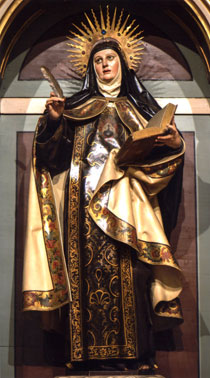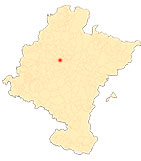pathway Teresian in Pamplona
The image of Saint Teresa in the Discalced Carmelite nuns
The titular sculpture of its altarpiece in the convent church of the Carmelites of San José of Pamplona is the one that presided in the old temple of the place del Castillo the chapel of its invocation, paid by Don Álvaro de Benavides, brother of the viceroy of Navarre, between 1653 and 1661, occupying the priory of the convent the Mother Mariana del Espíritu Santo. The missing altarpiece was contracted by Miguel Martínez de Heredia, secretary of the Holy Crusade and the master architect of Pamplona Martín de Legarra, under the supervision of the discalced Carmelite friar Martín de San José, in 1682.
The image, which was saved from the total destruction of the old convent, follows the model popularized by Gregorio Fernández, and undoubtedly comes from workshops in Valladolid, from where not only the Carmelites imported works, but also other orders such as the Jesuits who did the same with some heads of saints, the Immaculate Conception and some other Marian images. When it was installed in the new altarpiece, in its present location, it was completely repainted, having lost much of its seismic character.
In fact, the model of the saint standing, as an ecstatic writer and inspired by the Paraclete, with the habits of the barefoot, is invariably repeated in Navarre, from the first examples of the Valladolid school found in the Carmelite convents (Corella, Pamplona and Tudela -today in the parish of Murchante-), the eighteenth-century ones of Corella, Fitero or Santesteban and the last ones of academic orbit in these lands, like the relief of the altarpiece of Irurita, work of Alfonso Giraldo Bergaz (c. 1770).1770).
-
FERNÁNDEZ GRACIA, R., "El convento e iglesia de los Carmelitas Descalzos de Pamplona. Architecture", Príncipe de Viana, 164, 1981, pp. 787-818.
-
ECHEVERRÍA GOÑI, P. and FERNÁNDEZ GRACIA, R., "El convento e iglesia de los carmelitas descalzos de Pamplona. Exorno artístico", Príncipe de Viana, 164, 1981, pp. 819-891.
-
AZANZA LÓPEZ, J. J., Arquitectura Religiosa Barroca en Navarra, Pamplona, Government of Navarre, 1996.
-
FERNÁNDEZ GRACIA, R., El retablo barroco en Navarra, Pamplona, Government of Navarre, 2003.
-
FERNÁNDEZ GRACIA, R., The Immaculate Conception in Navarre. Art and devotion during the centuries of the Baroque Mentors, artists and iconography. Pamplona, Eunsa, 2004.
-
FERNÁNDEZ GRACIA, R., Engraving, Counter-Reformation and Teresian Carmel. The collection of engravings of the Discalced Carmelites of Pamplona and Leonor de la Misericordia (Ayanz and Beaumont). Pamplona, I. G. Castuera, 2004.
-
FERNÁNDEZ GRACIA, R., "Santa Teresa", Juan de Goyeneche y el triunfo de los navarros en la Monarquía Hispánica del siglo XVIII, Pamplona, Fundación Caja Navarra, 2005, p. 352.
-
FERNÁNDEZ GRACIA, R., "Algunas esculturas napolitanas en Navarra", Pulchrum. Scripta in honorem Mª Concepción García Gainza, Pamplona, Government of Navarre, department de Cultura y Turismo-Institución Príncipe de Viana, 2011, pp. 300-310.
-
TARIFA CASTILLA, M. J., "Aparición de Cristo a Santa Teresa", Pamplona y San Cernin 1611-2011. IV Centenary of the Vow of the City, Pamplona, Pamplona City Council, 2011, p. 176.












